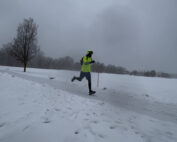
If you’ve decided to start running, congratulations! You’re taking the first step towards a healthier and happier life. But before you sprint out the door like a dog waiting for it’s owner, let’s talk about how to start running the right way. Running can be both simple and complicated, and too many beginner runners make the mistake of going out too fast and quickly get discouraged from running.

But fear not! By following a specific plan and taking it slow and steady, you’ll avoid getting injured or burnt out, and you’ll be more likely to enjoy running and stick with it in the long run. In this article, we’ll cover everything you need to know to start running as a beginner. And we’ll keep things light and fun.
Why You Shouldn’t Start Out Sprinting
First things first: sprinting out the door like a border collie running after a ball is not the best approach for beginner runners. While it may seem like a good idea at the time, doing too much too soon can lead to overtraining or getting an unwanted injury.
To avoid this, it’s important to follow a general plan and progress slowly and steadily. Studies show that you’re more likely to stick with running if you find a way to enjoy it and if you have a purpose for why you’re doing it. So, take a deep breath, relax, and let’s start with the basics.
The Run-Walk-Run Method
This philosophy is a great If you’re a beginner runner, the run-walk method is a great way to get started. This method, popularized by Olympian Jeff Galloway, involves alternating a few minutes of walking with a few minutes of running, gradually increasing the amount of time you spend running and decreasing the amount of time you spend walking.
Not only is this method effective for building endurance and preventing injury, it’s also a great way to focus on using good running form. As Denlinger explains, “Short periods of running (one to two minutes at a time) allow you to focus on using good running form. This helps prevent injury and helps you go farther, faster as you build up.”
So, how do you get started with the run-walk method?
If you’re a brand new runner start with three minutes of walking and one minute of running, then repeat over and over. If you are a more experienced runner, start with seven or eight minutes of running and one to two minute of walking, repeated over and over until your finished with your planned run.
It’s important to keep the running portions very easy and not to increase too much too fast, or else you can overload the muscles as they’re adjusting to the new stress and could get injured. You can increase your workload about 10% a week as a general rule of how not to over do it.
How to Prevent Injuries
To avoid injury, it’s important to build up a gradual and integrate strength and recovery program into your training.
Once a runner sustains an injury, they have a tendency to change how they run in order to compensate for what hurts. And it can cause additional injuries. This is where strength work comes in handy.
You gotta build up that leg and booty strength, and keep your form in check so you don’t end up hobbling around like a baby giraffe on stilts.
Fitness exercises that will help to include in your running training are: squats, lunges, clamshells (not the seafood kind), push-ups, planks, and burpees. And if you’re feeling some pain in your calves or feet and toes, don’t worry, it’s a common newbie issue. Plantar fasciitis, IT band problems, runner’s knee, and the dreaded shin splints can all be put to rest with a few simple preventative measures.
First of all, make sure you’ve got the right kicks on your feet. Go to an intimidating running shoe store and have a knowledgeable salesperson analyze your gait. And once you’ve got the cool looking shoes, keep track of how many miles you put on them. Once you hit 300-500 miles, it’s time to trade up for a new pair. Your joints will thank you.
In addition to running shoes, make sure you’re incorporating strength training into your routine. And don’t forget to take rest days! Your body needs to recover and build up strength, so don’t overdo it. And while you’re taking care of yourself, make sure to do some light stretching, foam rolling, and maybe even a little yoga while making funny sounds that make you feel silly..
Now, let’s talk about your form. It’s not just about looking like a gazelle gracefully bounding across the savannah. Your arms should be swinging up and down, not criss-crossing your body, that’s important. And don’t slouch like you’re hunched over a desk, lean forward slightly from the ankles instead of the hips. And if you’re gasping for air, try breathing in through your nose and out through your mouth. The more you think about your breathing, the better and will get at managing it.
Finally, when you’re ready to dial it in like a NHL goaltender on opening night, try out some running drills.
- High knees
- Butt kicks
- Fast feet
- Skipping like a child (yes, really!)
- Lateral shuffling
These will all help you engage different motions of your joints and get you feeling like a contortionist, or at least a flexible runner. So get out there and run like an ostrich. Or at least, like a deere.
Why Muscle-Pumping Workouts are Great for Beginners
Besides sculpting your calf muscles, feet, and ankles, you also gotta beef up your abs and upper body. By toning your core, glutes, lower back, hips, and shoulder muscles, you’ll develop the tenacity you need to stride over hills, around corners and past competitors..

What You Need Running Motivation
Ensure that you snag a pair of high-quality running sneakers. If you have a neighborhood running store – not one of those big box stores – then swing by there. The running store staff can assess your running technique, run a gait analysis, and offer shoe recommendations. Then, it’s up to you to try on those shoes and find the ones that make you excited about running..
Right running clothes – such as sweat-wicking tops and shorts or leggings – are linked to adhering to a running routine since they’re comfier and make you feel like a legit runner. A well-crafted pair of socks is critical to keeping your feet (and you!) joyous. And, if you’re feeling chilly or running in the dark, you need to wear layers and run with a blinking light.
But hold off on splurging on fancy watches, monitors, and heart rate trackers – at least for now. While there are several running gadgets to add to your checklist, it’s really not necessary, especially since cell phones already have that technology built it, you just need a cheap running phone holder.
Most importantly, you’ll require running buddies and some sort of a reward or goal. Research demonstrates that people are more inclined to adhere to a training plan if you have friends or a novice running team working out with them. And a cold beer after a race can be that reward some people, but most people just want to relish in their own victory after a race or personal goal achieved. Give yourself a pat on the back, and live in the moment.
Runners adhere to running because they relish it. So, how do you begin running if you’ve never started before? Enjoy yourself while doing it!
Runners like running because of the personal growth they experience from the pain they endure doing it. Nothing is easy and there are no shortcuts. Don’t think about how far you have ran, or how far you still need to run, only think about the next step, and be in the moment.







